Abstracts
Materials Challenges in Photoelectrochemical Water Splitting
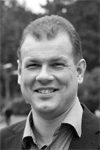
Roel van de Krol
Helmholtz-Zentrum Berlin für Materialien und Energie GmbH, Institute for Solar Fuels, Hahn-Meitner-Platz 1, 14109 Berlin, Germany
roel.vandekrol@helmholtz-berlin.de
The direct photo-electrochemical conversion of water and CO2 into chemical fuels represents an exciting new pathway for the combined conversion and storage of solar energy. One of the main challenges in this field is to find semiconductors that are efficient, chemically stable, and easy to synthesize. I will show recent progress on selected oxide-based semiconductors to illustrate some of the challenges in the design and optimization of these novel materials. Of particular interest is the interaction between semiconducting photoelectrodes and co-catalysts, such as cobalt phosphate. Although the latter are commonly assumed to enhance the reaction kinetics, there is compelling evidence that their main function is to passivate surface states. In the final part of the talk I will show initial results on the surface chemistry of BiVO4 studied under operando conditions with near-ambient pressure XPS, and on in-line XPS studies of ALD-grown TiO2 protection layers.
Photoinduced electron transfer reactions: from simple model systems to complex molecular architectures
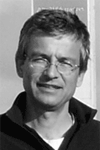
Eric Vauthey
Dpt. de Chimie Physique, Université de Genève, Switzerland
Eric.Vauthey@unige.ch
Although photoinduced electron transfer reactions have been very intensively studied, several important questions still remain unanswered. The first part of the lecture will focus on our recent investigations using femtosecond spectroscopy aiming to answer some these basic questions. They concern the driving-force dependence of the charge separation dynamics and the nature of the primary product (excited ions, exciplex, ...).
The second part will be devoted to the study of the origin of the photocurrent in multichromophoric architectures designed for photovoltaics. It will shown that symmetry-breaking charge separation, i.e. charge separation between two identical molecules, plays a key role in these systems.
Light conversion using organic semiconductors

Nathalie Banerji
Department of Chemistry, Faculty of Science, University of Fribourg, Switzerland
natalie.banerji@unifr.ch
Organic semiconductors offer numerous advantages compared to their inorganic counterparts, such as low-cost manufacturing, flexibility and lightweight. One important application is their use in new generation solar cells. The active layer of such photovoltaic devices often consists of a conjugated polymer, blended with a fullerene derivative in a solid-state thin film. In order to understand how those solar cells work and to improve their performance, it is important to investigate the light-matter interactions of the organic materials. We have done so by using a palette of experiments, spanning from ultrafast spectroscopy, via Stark effect methods, terahertz techniques, photocurrent measurements, to nanoscale mobility characterization. In this talk, I will discuss charge generation mechanisms in polythiophene:fullerene blends, with particular emphasis about the influence of the phase morphology and microstructure of the blends on the generation and recombination of charges. Next, I will present charge transfer dynamics from methyl ammonium lead iodide perovskites to organic hole transporting materials. Finally, I will give a brief overview of our most recent studies about organic semiconductors applied to biological sensors.
Towards a sustainable materials chemistry - metals, methods and metrics

Ed Constable
Department of Chemistry, University of Basel, Switzerland
edwin.constable@unibas.ch
The talk will commence by establishing the need for a new and sustainable materials chemistry. The next generation of materials and devices must balance performance with the constraints of deployability. Case histories from our own studies in the area of dye-sensitised solar cells and light-emitting devices will be used to exemplify the strategic approaches that are needed to balance the basic scientific drive with the societal needs and drivers. A particular emphasis will be placed upon out new "Surfaces as ligands, surfaces as complexes" approach in which self-repairing and self-regenerating material can be prepared.
Electrochemical interfaces investigated under operating conditions by ambient pressure X-ray photoelectron spectroscopy

Hendrik Bluhm
Chemical Sciences Division, Lawrence Berkeley National Laboratory, Berkeley, CA 94720
hbluhm@lbl.gov
Solid/liquid interfaces are ubiquitous in technological applications and govern numerous important phenomena, including corrosion, photoelectrochemical splitting of water, and electroplating. A detailed understanding of these processes requires the investigation of solid/liquid interfaces with chemical sensitivity and interface specificity under operating conditions. Ambient pressure X-ray photoelectron spectroscopy is an excellent method to probe the heterogeneous chemistry of these interfaces, and provides in addition the opportunity to measure the local potentials simultaneously with the chemical composition through the observation of shifts in the kinetic energy of the photoelectrons, which serve as a non-contact probe. The challenge for photoelectron experiments on solid/liquid interfaces under ambient conditions is not only the elevated pressure at which these experiments have to be carried out, but equally so the preparation of clean, well controlled samples with high cleanliness and reproducibility. This talk reviews the progress that has been made in the area of ambient pressure X-ray photoelectron spectroscopy experiments on liquid/solid interfaces, in particular electrochemical systems. The talk will also discuss different strategies for the preparation of liquid/solid interfaces suitable for photoelectron spectroscopy experiments, and provide an outlook on opportunities for future research in this field.
The versatility of mesoscopic solar cells
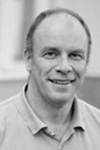
Anders Hagfeldt
Laboratory of Photomolecular Science, Swiss Federal Institute of Technology Lausanne (EPFL), Lausanne, Switzerland
Anders.Hagfeldt@epfl.ch
Since the seminal Nature paper by O’Regan and Grätzel in 1991 the highest efficiencies of dye-sensitized solar cells (DSC) have been achieved using the iodide/tri-iodide redox system. A disadvantage of this mediator is the large internal losses caused by the fact that it is a two-electron redox couple. In 2010 we made a breakthrough by using one-electron transfer redox systems such as cobalt-complexes, in combination with a new generation of organic dyes, which efficiently prevents recombination losses. This discovery was quickly embraced by the DSC community and the new world record for DSC is at present 14.3% by using a Co-complex redox couple and two organic dyes in a co-sensitized system.
The phenomenal breakthrough of the so called perovskite solar cells (PSC) originates from the ideas of replacing the dye layer adsorbed on the mesoporous oxide surface with an ultrathin inorganic perovskite layer and replacing the liquid electrolyte with a solid-state hole conductor. We will report on our latest work on optimizing the solar cell efficiency that at present is certified at 21% in our laboratories.
Dynamics of photoinduced charge separation in solar energy conversion systems
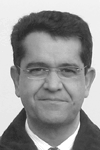
Jaques Moser
Photochemical Dynamics Group, Institute of Chemical Sciences & Engineering, EPFL, Switzerland
je.moser@epfl.ch, http://photochemistry.epfl.ch
A photoelectrochemical (PEC) tandem cell device can convert solar energy directly into a storable chemical vector like hydrogen via water splitting, or methanol via carbon dioxide reduction. While many complex and expensive systems have been developed to accomplish this, the identification of suitable materials to enable the cost-effective PEC energy conversion has remained a challenge. Semiconductor oxides offer many advantages in cost, availability, and stability toward photoelectrochemical reactions. Besides, dye-sensitized systems and hybrid organic-inorganic lead halide perovskites have already proved to be credible contenders for third generation photovoltaics. Combined with a stable catalyst or included in a tandem PEC device, these highly efficient solar cells also show hydrogen production promise.
All solar energy conversion systems involve ultrafast key processes (such as photoinduced electron transfer, carrier trapping and association, energy transfer and relaxation) as initial steps for light-induced charge separation in materials and at their interfaces. Scrutinizing the dynamics of slower back electron transfer and recombination is equally important, as these processes compete with charge transport and collection and are then detrimental to the performance of devices. Here, we will show how a variety of time-resolved spectroscopy probing techniques can be applied to achieve a fundamental understanding of these phenomena and eventually improve the design and efficiency of promising novel solar energy conversion systems.
Time-resolved X-ray absorption spectroscopy to study molecular systems for light to chemical energy conversion
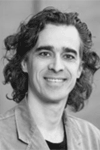
Jeroen A. van Bokhoven1 and Grigory Smolentsev2
1ETH Zurich, Institute for Chemical and Bioengineering, Switzerland, Paul Scherrer Institute, Switzerland, jeroen.vanbokhoven@chem.ethz.ch
2Paul Scherrer Institute, Switzerland, grigory.smolentsev@psi.ch
First the introduction to the X-ray absorption spectroscopy will be given. Information that can be extracted from EXAFS, XANES and pre-edge region of X-ray absorption spectra will be discussed. Basic principles of X-ray absorption measurements at synchrotron sources will be described. Then we will introduce recent advances in the field of time-resolved X-ray absorption spectroscopy that provide information on local structure around metal centers, their orbital structure and oxidation state, and thereby insights into the mechanisms of their photochemical reactions. Photosensitizers with metal centers, multicomponent molecular catalytic systems for H2 evolution and supramolecular systems sensitizer-catalysts with two metal centers are used as examples to demonstrate the possibilities of the technique. We overview different experimental methods that can be used to investigate intermediates with lifetimes in the range from hundreds of picoseconds to hundreds of microseconds. Theoretical methods to extract the structural and electronic information from X-ray absorption near edge structure spectroscopy (XANES) are also discussed.
Modeling of eletrochemical reactions using density functional theory
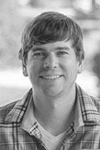
Felix Studt
Institute of Catalysis Research and Technology (IKFT), Karlsruhe Institute of Technology (KIT), Germany
felix.studt@kit.edu
Artificial photosynthesis—from catalysts to photoelectrochemical cells for solar fuels

Licheng Sun
Department of Chemistry, School of Chemical Science and Engineering, KTH Royal Institute of Technology, 10044 Stockholm, Sweden and State Key Lab of Fine Chemicals, Institute of Artificial Photosynthesis, KTH-DUT Joint Education and Research Center on Molecular Devices, Dalian University of Technology (DUT), 116024 Dalian, China
lichengs@kth.se
This lecture includes the topics of following research fields:
- Molecular catalysts for water oxidation and mechanisms of O-O bond formation inspired by the active site of oxygen evolving complex (OEC) in Photosystem II
- Molecular catalysts for hydrogen generation and mechanisms of H-H bond formation inspired by the active site of [FeFe]-Hydrogenases
- Electrocatalysts for water oxidation based on metal oxides (hydroxides)
- Electrocatalysts for hydrogen generation based on metal oxides nano-films
- Photoanodes for water oxidation based on hybrid materials
- Photocathodes for hydrogen generation based on hybrid materials
Computational investigation and design of bio-inspired water oxidation catalysts

Sandra Luber
Department of Chemistry, University of Zurich, Switzerland
sandra.luber@chem.uzh.ch
Solar energy is an inexhaustible energy source for a sustainable solution to the global energy consumption. The storage of large amounts of light energy can be achieved by conversion into chemical energy saved in biomass. Artificial photosynthesis permits the splitting of water into molecular hydrogen and oxygen and is therefore a very promising strategy to meet the increasing worldwide need for clean energy. This requires the development of high-performance water reduction and water oxidation catalysts (WOCs) where the latter is currently the main bottleneck for efficient photocatalytic water splitting. Very recently, the first Co(II)-based cubane WOCs have been presented, which excel through unprecedented structural analogies to the oxygen-evolving complex of nature’s photosystem II. We study their properties and catalytic behavior by means of density functional theory (DFT) in combination with DFT-based molecular dynamics. Moreover, structurally simpler Co-based WOCs are investigated in detail, which allows the derivation of important guidelines for smart design of novel efficient WOCs.
Time-resolved UV/VIS and IR spectroscopy of artificial photosynthetic systems
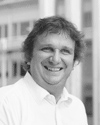
Peter Hamm
Department of Chemistry, University of Zurich, Switzerland
peter.hamm@chem.uzh.ch
A variety of time-resolved spectroscopic studies will be discussed, which are aimed to get a mechanistic insights in artificial photosynthetic systems. That is, a homogeneous water reduction system will be discussed, which employs quinones as a reversible electron shuttle [1], as well as the electron transfer and protonation steps in a supramolecular construct that has been designed to accumulate two charges at a central anthraquinon [2]. Finally, as a preparation for equivalent studies on surfaces, the newly developed technique of 2D ATR IR will be introduced together with a couple of proof-of-principle experiments [3,4].
[1] A. Rodenberg, M. Orazietti, M. Mosberger, C. Bachmann, B. Probst, R. Alberto and Peter Hamm, Quinones as reversible electron relays in artificial photosynthesis, ChemPhysChem, 2016, in press, DOI: 10.1002/cphc.201501085
[2] M. Orazietti, M. Kuss-Petermann, P. Hamm and O. S. Wenger, Light-driven electron accumulation in a molecular pentad, Angew. Chem. Int. Ed., 2016, 10.1002/anie.201604030
[3] J. P. Kraack, D. Lotti and P. Hamm, 2D Attenuated total reflectance infrared spectroscopy reveals ultrafast vibrational dynamics of organic monolayers at metal-liquid interfaces, J. Chem. Phys. 142 (2015) 212413
[4] D. Lotti, P. Hamm and J. Kraack, Surface-sensitive spectro-electrochemistry using ultrafast 2D ATR IR spectroscopy, J. Phys. Chem. C, 120 (2016), 2883-2892
Adsorption studies of molecular catalysts and photosensitizers on model oxide surfaces
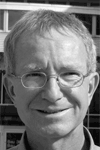
Jürg Osterwalder
Department of Physics, University of Zürich
osterwal@physik.uzh.ch
Oxide semiconductors represent important constituents of current PEC water splitting devices. In this talk, fundamental aspects of oxide surfaces will be addressed and how they are studied with rigorous surface science methods in the context of two important scenarios. In the first, TiO2(110) and Cu2O(111) surfaces are used as support for molecular water reduction catalysts. Adsorption geometries and band alignments are characterized, as well as surface band bending effects following molecule adsorption or oxygen defect formation. In the second scenario, corrosion-resistant ultrathin films of alumina are prepared and characterized, with the aim of studying charge transfer processes from adsorbed photosensitizer molecules through an oxide tunneling barrier of variable thickness